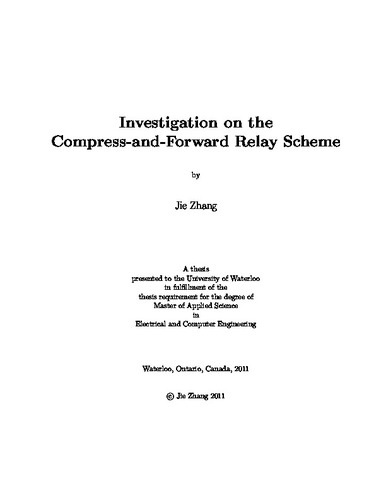UWSpace will be migrating to a new version of its software from July 29th to August 1st. UWSpace will be offline for all UW community members during this time.
Investigation on the Compress-and-Forward Relay Scheme
| dc.contributor.author | Zhang, Jie | |
| dc.date.accessioned | 2012-01-20 21:23:39 (GMT) | |
| dc.date.available | 2012-01-20 21:23:39 (GMT) | |
| dc.date.issued | 2012-01-20T21:23:39Z | |
| dc.date.submitted | 2012 | |
| dc.identifier.uri | http://hdl.handle.net/10012/6495 | |
| dc.description.abstract | The relay channel plays an integral role in network communication systems. An intermediate node acts as a relay to facilitate the communication between the source and the destination. If the rate of codewords is less than the capacity of the source-relay link, the relay can decode the source's messages and forward them to the destination. On the contrary, if the rate of codewords is greater than the capacity of the source-relay link, the relay cannot decode the messages. Nevertheless, the relay can still compress its observations and then send them to the destination. Obviously, if the relay-destination link is of a capacity high enough such that the relay's observations can be losslessly sent to the destination, then the maximum message rate can be achieved as if the relay and the destination can jointly decode. However, when the relay-destination link is of a limited capacity such that the relay's observation cannot be losslessly forwarded to the destination, then what is the maximum achievable rate from the source to the destination? This problem was formulated by Cover in another perspective [7], i.e., what is the minimum rate of the relay-destination link such that the maximum message rate can be achieved? We try to answer this Cover's problem in this thesis. First, a sufficient rate to achieve the maximum message rate can be obtained by Slepian-Wolf coding, which gives us an upper bound on the optimal relay-destination link rate. In this thesis, we show that under some channel conditions, this sufficient condition is also necessary, which implies that Slepian-Wolf coding is already optimal. Hence, the upper bound meets exactly the minimum value of the required rate. In our approach, we start with the standard converse proof. First, we present a necessary condition for achieving the maximum message rate in the single-letter form. Following the condition, we derive a theorem, which is named as "single-letter criterion". The "single-letter criterion" can be easily utilized to verify different channels. Then we show that for two special cases: when the source-relay link and the source-destination link of the relay channel are both binary symmetric channels (BSCs), and when they are both binary erasure channels (BECs), Slepian-Wolf coding is optimal in achieving the maximum message rate. Moreover, the maximum message rates of these two special channels are also calculated in this thesis. | en |
| dc.language.iso | en | en |
| dc.publisher | University of Waterloo | en |
| dc.subject | Relay Channel | en |
| dc.subject | Compress-and-Forward Scheme | en |
| dc.title | Investigation on the Compress-and-Forward Relay Scheme | en |
| dc.type | Master Thesis | en |
| dc.pending | false | en |
| dc.subject.program | Electrical and Computer Engineering | en |
| uws-etd.degree.department | Electrical and Computer Engineering | en |
| uws-etd.degree | Master of Applied Science | en |
| uws.typeOfResource | Text | en |
| uws.peerReviewStatus | Unreviewed | en |
| uws.scholarLevel | Graduate | en |

